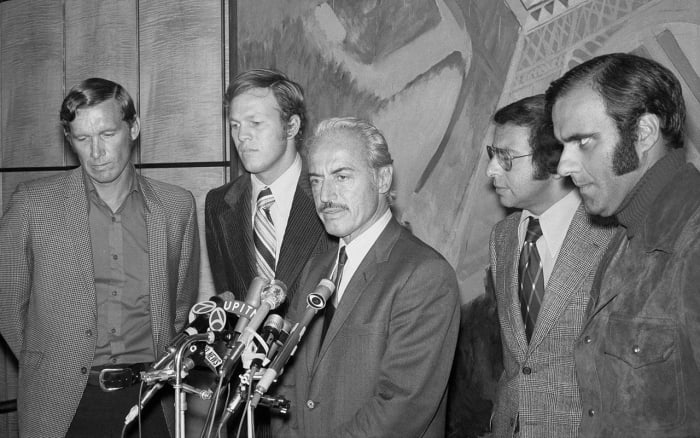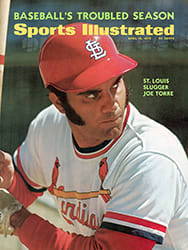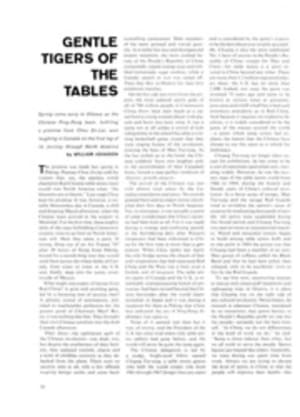Digging In At Crooked Creek
Along about the middle of spring training the world champion Pittsburgh Pirates locked themselves in their clubhouse at Bradenton, Fla. to vote on a proposal that would authorize action against baseball's owners unless certain moneys were forthcoming to sweeten an already fat pension plan. The Pirate meeting lasted about an hour. Afterward, when Dave Giusti, the team's player representative, was asked why it had taken so long, he said, "The main problem I had was to tell some of the players how to spell the word strike."
By the end of last week, with the opening game only a few days away, all the players knew the word well enough. They vacated training sites in Arizona, Florida and California, forcing the postponement of the remaining exhibition games and imperiling a season that had been rich with promise. Owners and players alike seemed to have their heels dug in over the players' request for a 17% cost-of-living adjustment in the pension plan. At present the plan pays a four-year major-leaguer $2,092.08 a year at the age of 45, or $7,416.48 at 65. Men who play longer are guaranteed increasingly higher benefits under a retirement program unimaginable to most workers in the nation today. Take Joe Gibbon as an example. A 37-year-old pitcher for Cincinnati who has averaged 54 innings of work over the last four seasons, he can cash in at the age of 45 after 12 years in the majors and draw $5,584.32 a year for the rest of his life. Or he can wait until age 65 and receive $19,501.32.
The owners seemed united and militant in their stand, while the players were also united, albeit somewhat confused and, on the whole, anxious to play. Pension money triggered the strike, but the players had another, more emotional, impulse: a feeling that the owners were trying to destroy the Players Association because of their deep-seated dislike of Executive Director Marvin Miller.
John Gaherin, negotiator for the owners, and Miller continued to meet in New York at the end of a fruitless week. The owners were unwilling either to hike the pension or bring in an arbitrator—a way out proposed by the players. And the fans were in a position reminiscent of the people who used to go to the edge of a very crooked creek in Alabama. The creek was so crooked that no matter how hard or often they tried to jump over it they kept coming down on the wrong side. Eventually, of course, they learned to walk around it.
Before the furor, and the unexpected death of New York Met Manager Gil Hodges, the game appeared to be having a delightful spring. Some of the players even seemed to like what they were doing. "It's odd, isn't it," Al Kaline said one day, "that you have to come to the end of the line before you realize how lucky you are." Steve Arlin, a practicing dentist of 26 who pitched in such tough luck for the San Diego Padres last season that he had a 9-19 record and did not even gel his face on the bubble-gum cards, was philosophic. "I'm not in this game to quality for a four-year pension," Arlin said. "Dentistry is my backup job, my insurance policy. I'm in the major leagues because I want to do certain things, and 9-19 isn't what I have in mind. If I pitch until I'm 34 I can still practice dentistry for 30 years. If I didn't play baseball I'm sure I would look back at age 40 and wonder about the blank space in my life. Baseball brings an added richness."
Virtually every day crowds of people flocked to Bradenton to see the Pirates at work—and to scrutinize Manager Bill Virdon and Danny Murtaugh, his predecessor. When Murtaugh retired last fall he was heeding an old saying: "I want to be able to walk through the garden while I can still smell the roses." Today Murtaugh is the Pirates' director of player acquisition and development, and thus a man concerned with youth. One morning he assembled all the young infielders and spoke to them. "Gentlemen," he said, "if you look at the big club you will notice that some of our infielders are getting a little old. A minimum of six times this season Manager Bill Virdon is going to have to reach down into our minor league system and bring someone up. It will seldom be the best athlete. It will be the man the Pirates believe can do the things needed now. In Pittsburgh there is no sitting around. If you get to the Pirates, gentlemen, you will play."
Murtaugh made no such promise to fledgling outfielders. What with Stargell, Clemente et al. around, so talented a slugger as Richie Zisk was sent to the minors last week. "I'm like an extra time player in the New York Philharmonic," said Zisk mournfully.
This year's new franchise is in Arlington, Texas, a community of 110,000 generally considered to be located right where the hyphen is in Dallas-Fort Worth. The Cleveland Indians have been sold again, this time to Nick Mileti, "The Sicilian Bill Veeck." (Indian fans, of course, set their alarm clocks to ring every five years because that's when the tax shelters run out and the club has to be sold again.) There are new uniforms all over the place and the most spectacular are the red, white and blue ones to be worn by the Atlanta Braves. The biggest ovation of the year probably will go to a man wearing one of those new uniforms, Henry Aaron, on the night of July 25, when he steps up to hit in the All-Star Game at Atlanta. Aaron is starting his countdown toward Babe Ruth's record of 714 home runs and he needs 76 to break it. A most popular man, Aaron over the last two seasons has accumulated more All-Star votes than any other player—2,514,163. Next come Johnny Bench, 2,151,785; Boog Powell, 1,833,043; Brooks Robinson, 1,725,561; Willie Mays, 1,669,893; and Carl Yastrzemski, 1,659,739.
Bench, of course, is trying to make a big comeback with the revamped Reds in Cincinnati. And John has a new idea. He has said that he will not tip his cap to fans when he hits a homer. History tells us that two things happen to a man who docs not tip his cap: a) he is booed; b) he becomes manager of the Texas Rangers.
As usual, there were rookies in plenty this spring and some fascinating ones, at that. One seemed to come out of the blue sky over Lakeland, Fla. Fred Holdsworth, a 19-year-old right-handed pitcher, although eventually sent to Toledo for regular work, looks like he might become the fourth starter Detroit has been searching for in its attempt to overtake Baltimore. Holdsworth is a Detroit area boy who was valedictorian of his high school class. "Valedictorian?" Manager Billy Martin said. "Does that mean you get to eat lunch first?"
This is the season after all those winter trades and the players seem as bewildered as the fans. Frank Robinson is in Los Angeles and Jim Fregosi in New York. Lee May will be playing in Houston while Alex Johnson is shooting for a comeback in Cleveland. Nolan Ryan is in Anaheim and Denny McLain in Oakland while Sudden Sam McDowell has lit in San Francisco.
(And talk about a different drum. Remember Richie-Dick Allen? At first reported lost, he signed a contract with the White Sox at approximately the same time the rest of the players were striking.)
It could be that some of the trades that did not receive large headlines will turn out to decide the pennant races. The Twins, for example, picked up two of the prime relief pitchers in baseball—Wayne Granger from Cincinnati and Dave LaRoche from California. When Bill Rigney has two such pitchers to juggle around there is no telling what might happen. It is said of Twin pitchers that when Rigney allows a man to work a complete game the pitcher goes home, sits on the bed and keeps repeating. "I can't believe I pitched the whooole thing." LaRoche is the man who stood on his head in the corner of the dressing room after giving up a couple of runs in a game last year. Another time he hid under a table. "I just like to relax," he explained.
To be sure, neither LaRoche's pitching nor his methods of relaxation will close the gap between the National and American leagues, which seems wider now than ever before. In the last two years the Nationals outdrew the Americans by over 10 million fans. It doesn't help that Frank Robinson, Sam McDowell and Jim Fregosi, drawing cards all, were traded out of the American League. Nor is it encouraging to reflect that the league will be without Vida Blue for at least a month; that Frank Howard did not swing a bat in spring training; that Denny McLain lost 22 games in 1971; that Kansas City's Freddie Patek, the league leader in triples and No. 2 man in stolen bases, is on the disabled list as the season starts; that Yaz did not have a good spring.
The subject of leadership on the Baltimore Orioles became a daily thing this spring. The departure of Frank Robinson had caused some optimism around the league that without Robinson the Orioles may find themselves in a tough pennant chase. The Orioles tend to minimize the situation because they feel the lessons taught by Robinson have been well learned. What Frank himself says is this: "If I had to pinpoint the leader this year I really couldn't say. Brooks [Robinson] is not made that way and Boog [Powell] shies away from the role. Among the pitchers, Dave McNally is a line leader. He plays when he's hurt and battles all the time. Among the players who play every day, I think Merv Rettenmund might turn out to be the leader type."
Watch for that, and also note the wonders weight-watching has wrought throughout the game. Mike Epstein of the Oakland A's dropped 17 pounds, George Scott of Milwaukee 20, Les Cain of Detroit 30 and McDowell 18. The man probably most responsible was Joe Tone of the Cardinals (see cover), who went on a water diet two years ago, lost 15 pounds, and in 1971 became the National League's Most Valuable Player.
Torre did everything. He hit .363, drove in 137 runs and collected 230 hits while accounting for 352 total bases. In no month of the season did his batting average go below .324, and his pattern was all but incredible: .363 against righthanders, .362 against lefthanders.
This spring Torre signed two one-year contracts with the Cardinals calling for $130,000 in 1972 and $150,000 in 1973. He is one of some 25 players currently making over $100,000.
"The oddest thing about my signing," Torre says, "is that not too many people knew that I had made $100,000 last year. This winter people wouldn't ask me what I hit, but what I weighed. Before I signed I was running laps to get myself ready. One afternoon a kid came up oil a bicycle. I had on a red jacket, sweat pants and sneakers. He said, "You a ballplayer?' I told him I was. 'Who'd you play for last year?" he asked. I told him the Cardinals. 'What's your name?" Torre. 'What position did you play?" Third base. He said, 'I met a player named Russ Snyder once,' and pedaled off. I sure earned some kind of fame.
"In many ways maybe the best thing that happened to me was when we traded Richie Allen at the end of the 1970 season. I had come to St. Louis when they had Brock, Flood, McCarver—players like that—so true pressure was never on me. When I played in Atlanta the real pressure was on Henry Aaron. When he didn't get a hit in a big situation the whole bench would deflate. When Allen left the Cards the pressure shifted to me. Actually, it isn't pressure so much as it is responsibility. Now I know that the guys are looking to me and I can't gel down on myself because they are watching. I never rooted and hollered as much on a bench as I did last year because I didn't want anyone to get down on themselves or the team.
"When we lost Bob Gibson for a month, it wasn't just a matter of his missing three or four turns in the pitching rotation. We missed him on the bench. He keeps everybody up, needles you, corrects you, challenges you to be better. One night in Philadelphia I got two hits my first two times up and then popped up a pitch I should have really done something with. I normally don't show any emotion unless I get mad at an umpire. I don't bust watercoolers or throw-bats. But I was mad and sat down next to Gibson and told him I should have had the third hit. He said, 'You really think you can get a hit everytime up?" I told him I did. 'Shhh,' he said. 'Even I can't do that.' "
That's with the ball parks open, of course.
ILLUSTRATION


